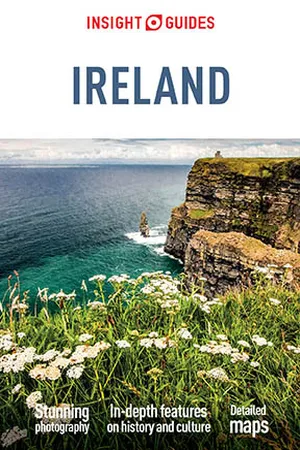
- English
- ePUB (mobile friendly)
- Available on iOS & Android
Insight Guides Ireland
About this book
Ireland packs many delights into its compact size and its main attractions - from the Wild Atlantic Way to its pubs and craic and numerous places of interest - are only the beginning. Be inspired to visit by the new edition of Insight Guide Ireland, a comprehensive full-colour guide to both the Republic and Northern Ireland.
Inside Insight Guide Ireland:
A fully-overhauled major new edition by our expert Irish author.Stunning, specially-commissioned photography that brings this fascinating country and its people to life. Highlights of the country's top attractions, including the art treasures of the Rijksmuseum and the picture-perfect small towns of Edam and Delft.Descriptive region-by-region accounts cover the whole country from the perennial favourite of Amsterdam to the sandy beaches in the country's north.Detailed, high-quality maps throughout will help you get around and travel tips give you all the essential information for planning a memorable trip.
About Insight Guides: Insight Guides has over 40 years' experience of publishing high-quality, visual travel guides. We produce around 400 full-colour print guide books and maps as well as picture-packed eBooks to meet different travellers' needs. Insight Guides' unique combination of beautiful travel photography and focus on history and culture together create a unique visual reference and planning tool to inspire your next adventure.
'Insight Guides has spawned many imitators but is still the best of its type.' - Wanderlust Magazine
Frequently asked questions
- Essential is ideal for learners and professionals who enjoy exploring a wide range of subjects. Access the Essential Library with 800,000+ trusted titles and best-sellers across business, personal growth, and the humanities. Includes unlimited reading time and Standard Read Aloud voice.
- Complete: Perfect for advanced learners and researchers needing full, unrestricted access. Unlock 1.4M+ books across hundreds of subjects, including academic and specialized titles. The Complete Plan also includes advanced features like Premium Read Aloud and Research Assistant.
Please note we cannot support devices running on iOS 13 and Android 7 or earlier. Learn more about using the app.
Information




Table of contents
- Ireland’s Top 10 Attractions
- Editor’s Choice
- Introduction: The New Ireland
- The Irish Character
- Insight: Ireland in the Movies
- Decisive Dates
- Ireland’s Invaders
- Insight: Ireland’s Finest Ruins
- The Making of a Nation
- Insight: Dublin at War
- Living with Partition
- Ireland Transformed
- Music
- The Irish Way With Words
- Insight: Arts Festivals
- Contemporary Art
- Food
- Pubs
- A Sporting Nation
- Golf
- Angling
- Walking in Ireland
- Insight: Ireland’s Architecture
- Introduction: Places
- Dublin
- Insight: Bloomsday
- Excursions from Dublin
- Insight: Horse Culture
- The Southeast
- Cork and Surroundings
- The Southwest
- Limerick and the Shannon Region
- Insight: The Burren
- Galway and the West
- Inland Ireland
- The Northwest
- Northern Ireland
- Belfast
- Transport
- A-Z: A Handy Summary of Practical Information
- Further Reading